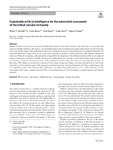Mostrar o rexistro simple do ítem
Explainable artificial intelligence for the automated assessment of the retinal vascular tortuosity
| dc.contributor.author | Hervella, Álvaro S. | |
| dc.contributor.author | Ramos, Lucía | |
| dc.contributor.author | Rouco, J. | |
| dc.contributor.author | Novo Buján, Jorge | |
| dc.contributor.author | Ortega Hortas, Marcos | |
| dc.date.accessioned | 2024-04-24T07:27:48Z | |
| dc.date.available | 2024-04-24T07:27:48Z | |
| dc.date.issued | 2024 | |
| dc.identifier.citation | Hervella, Á.S., Ramos, L., Rouco, J. et al. Explainable artificial intelligence for the automated assessment of the retinal vascular tortuosity. Med Biol Eng Comput 62, 865–881 (2024). https://doi.org/10.1007/s11517-023-02978-w | es_ES |
| dc.identifier.uri | http://hdl.handle.net/2183/36328 | |
| dc.description | Financiado para publicación en acceso aberto: Universidade da Coruña/CISUG | es_ES |
| dc.description.abstract | [Abstract]: Retinal vascular tortuosity is an excessive bending and twisting of the blood vessels in the retina that is associated with numerous health conditions. We propose a novel methodology for the automated assessment of the retinal vascular tortuosity from color fundus images. Our methodology takes into consideration several anatomical factors to weigh the importance of each individual blood vessel. First, we use deep neural networks to produce a robust extraction of the different anatomical structures. Then, the weighting coefficients that are required for the integration of the different anatomical factors are adjusted using evolutionary computation. Finally, the proposed methodology also provides visual representations that explain the contribution of each individual blood vessel to the predicted tortuosity, hence allowing us to understand the decisions of the model. We validate our proposal in a dataset of color fundus images providing a consensus ground truth as well as the annotations of five clinical experts. Our proposal outperforms previous automated methods and offers a performance that is comparable to that of the clinical experts. Therefore, our methodology demonstrates to be a viable alternative for the assessment of the retinal vascular tortuosity. This could facilitate the use of this biomarker in clinical practice and medical research. | es_ES |
| dc.description.sponsorship | Open Access funding provided thanks to the CRUE-CSIC agreement with Springer Nature. This work is supported by Ministerio de Ciencia e Innovación, Government of Spain (RTI2018-095894-B-I00, PID2019-108435RB-I00, TED2021-131201B-I00, and PDC2022-133132-I00 research projects); Consellería de Cultura, Educación e Universidade, Xunta de Galicia (Grupos de Referencia Competitiva ref. ED431C 2020/24 and postdoctoral fellowship ref. ED481B-2022-025). CITIC, Centro de Investigación de Galicia ref. ED431G 2019/01, receives financial support from Consellería de Cultura, Educación e Universidade, Xunta de Galicia, through the ERDF of the European Union (80%) and Secretaría Xeral de Universidades (20%). Funding for open access charge: Universidade da Coruña/CISUG. | es_ES |
| dc.description.sponsorship | Xunta de Galicia; ED431C 2020/24 | es_ES |
| dc.description.sponsorship | Xunta de Galicia; ED481B-2022-025 | es_ES |
| dc.description.sponsorship | Xunta de Galicia; ED431G 2019/01 | es_ES |
| dc.language.iso | eng | es_ES |
| dc.publisher | Springer | es_ES |
| dc.relation | info:eu-repo/grantAgreement/AEI/Plan Estatal de Investigación Científica y Técnica y de Innovación 2017-2020/RTI2018-095894-B-I00/ES/DESARROLLO DE TECNOLOGIAS INTELIGENTES PARA DIAGNOSTICO DE LA DMAE BASADAS EN EL ANALISIS AUTOMATICO DE NUEVAS MODALIDADES HETEROGENEAS DE ADQUISICION DE IMAGEN OFTALMOLOGICA | es_ES |
| dc.relation | info:eu-repo/grantAgreement/AEI/Plan Estatal de Investigación Científica y Técnica y de Innovación 2017-2020/PID2019-108435RB-I00/ES/CUANTIFICACIÓN Y CARACTERIZACIÓN COMPUTACIONAL DE IMAGEN MULTIMODAL OFTALMOLÓGICA: ESTUDIOS EN ESCLEROSIS MÚLTIPLE | es_ES |
| dc.relation | info:eu-repo/grantAgreement/AEI/Plan Estatal de Investigación Científica y Técnica y de Innovación 2021-2024/TED2021-131201B-I00/ES/DIAGNÓSTICO DIGITAL: TRANSFORMACIÓN DE LA DETECCIÓN DE ENFERMEDADES NEUROVASCULARES Y DEL TRATAMIENTO DE LOS PACIENTES | es_ES |
| dc.relation | info:eu-repo/grantAgreement/AEI/Plan Estatal de Investigación Científica y Técnica y de Innovación 2021-2024/PDC2022-133132-I00/ES/MEJORAS EN EL DIAGNÓSTICO E INVESTIGACIÓN CLÍNICO MEDIANTE TECNOLOGÍAS INTELIGENTES APLICADAS LA IMAGEN OFTALMOLÓGICA | es_ES |
| dc.relation.uri | https://doi.org/10.1007/s11517-023-02978-w | es_ES |
| dc.rights | Atribución 3.0 España | es_ES |
| dc.rights.uri | http://creativecommons.org/licenses/by/3.0/es/ | * |
| dc.subject | Blood vessels | es_ES |
| dc.subject | Eye fundus | es_ES |
| dc.subject | Ophthalmology | es_ES |
| dc.subject | Deep learning | es_ES |
| dc.subject | Genetic algorithms | es_ES |
| dc.title | Explainable artificial intelligence for the automated assessment of the retinal vascular tortuosity | es_ES |
| dc.type | info:eu-repo/semantics/article | es_ES |
| dc.rights.access | info:eu-repo/semantics/openAccess | es_ES |
| UDC.journalTitle | Medical & Biological Engineering & Computing | es_ES |
| UDC.volume | 62 | es_ES |
| UDC.startPage | 865 | es_ES |
| UDC.endPage | 881 | es_ES |
| dc.identifier.doi | 10.1007/s11517-023-02978-w |
Ficheiros no ítem
Este ítem aparece na(s) seguinte(s) colección(s)
-
GI-VARPA - Artigos [76]






